
Stratasys (SSYS)
Stratasys is up against the odds. Not only did its demand evaporate but also its negative returns on capital show it destroyed shareholder value.― StockStory Analyst Team
1. News
2. Summary
Why We Think Stratasys Will Underperform
Born from the Founder’s idea of making a toy frog with a glue gun, Stratasys (NASDAQ:SSYS) offers 3D printers and related materials, software, and services to many industries.
- Products and services are facing significant end-market challenges during this cycle as sales have declined by 5.6% annually over the last two years
- Projected sales for the next 12 months are flat and suggest demand will be subdued
- Historical operating margin losses point to an inefficient cost structure


Stratasys doesn’t live up to our standards. We see more lucrative opportunities elsewhere.
Why There Are Better Opportunities Than Stratasys
High Quality
Investable
Underperform
Why There Are Better Opportunities Than Stratasys
At $9.02 per share, Stratasys trades at 44.9x forward P/E. The current multiple is quite expensive, especially for the tepid revenue growth.
There are stocks out there similarly priced with better business quality. We prefer owning these.
3. Stratasys (SSYS) Research Report: Q3 CY2025 Update
3D printing company Stratasys (NASDAQ:SSYS) met Wall Streets revenue expectations in Q3 CY2025, but sales fell by 2.2% year on year to $137 million. The company’s outlook for the full year was close to analysts’ estimates with revenue guided to $555 million at the midpoint. Its non-GAAP profit of $0.02 per share was $0.02 above analysts’ consensus estimates.
Stratasys (SSYS) Q3 CY2025 Highlights:
- Revenue: $137 million vs analyst estimates of $136.6 million (2.2% year-on-year decline, in line)
- Adjusted EPS: $0.02 vs analyst estimates of $0 ($0.02 beat)
- Adjusted EBITDA: $5.04 million vs analyst estimates of $5.39 million (3.7% margin, 6.5% miss)
- The company reconfirmed its revenue guidance for the full year of $555 million at the midpoint
- Management reiterated its full-year Adjusted EPS guidance of $0.15 at the midpoint
- EBITDA guidance for the full year is $31 million at the midpoint, above analyst estimates of $30.43 million
- Operating Margin: -16.6%, up from -18.2% in the same quarter last year
- Market Capitalization: $811.8 million
Company Overview
Born from the Founder’s idea of making a toy frog with a glue gun, Stratasys (NASDAQ:SSYS) offers 3D printers and related materials, software, and services to many industries.
Stratasys traces its roots back to the late 1980s when it was founded by S. Scott Crump, the inventor of fused deposition modeling (FDM) technology. This breakthrough changed the world of additive manufacturing, enabling the production of complex 3D printers parts layer by layer. Today, the company serves a wide array of industries from aerospace and healthcare to healthcare and education.
Stratasys offers a wide range of 3D printers and related materials, softwares, and services. Whether it's rapid prototyping, tooling production, or end-use part manufacturing, Stratasys's advanced 3D printing systems cater to a wide range of applications and enable manufacturers to bring their ideas to life. One of Stratasys's flagship products is the FDM (Fused Deposition Modeling) 3D printer series which use thermoplastic materials to build prototypes and functional parts.
The company often enters into long-term contracts with its customers, particularly in the case of large-scale installations or ongoing service agreements. These contracts typically involve provisions for equipment procurement, maintenance services, software licensing, and consumables supply. By establishing contractual relationships with customers, Stratasys can secure recurring revenue streams and build long-term partnerships.
4. Custom Parts Manufacturing
Onshoring and inventory management–themes that grew in focus after COVID wreaked havoc on global supply chains–are tailwinds for companies that combine economies of scale with reliable service. Many in the space have adopted 3D printing to efficiently address the need for bespoke parts and components, but all companies are still at the whim of economic cycles. For example, consumer spending and interest rates can greatly impact the industrial production that drives demand for these companies’ offerings.
Competitors offering similar products include 3D Systems (NYSE:DDD), Desktop Metal (NYSE:DM), Proto Labs (NYSE:PRLB).
5. Revenue Growth
A company’s long-term sales performance can indicate its overall quality. Any business can experience short-term success, but top-performing ones enjoy sustained growth for years. Unfortunately, Stratasys struggled to consistently increase demand as its $561.5 million of sales for the trailing 12 months was close to its revenue five years ago. This wasn’t a great result and suggests it’s a low quality business.
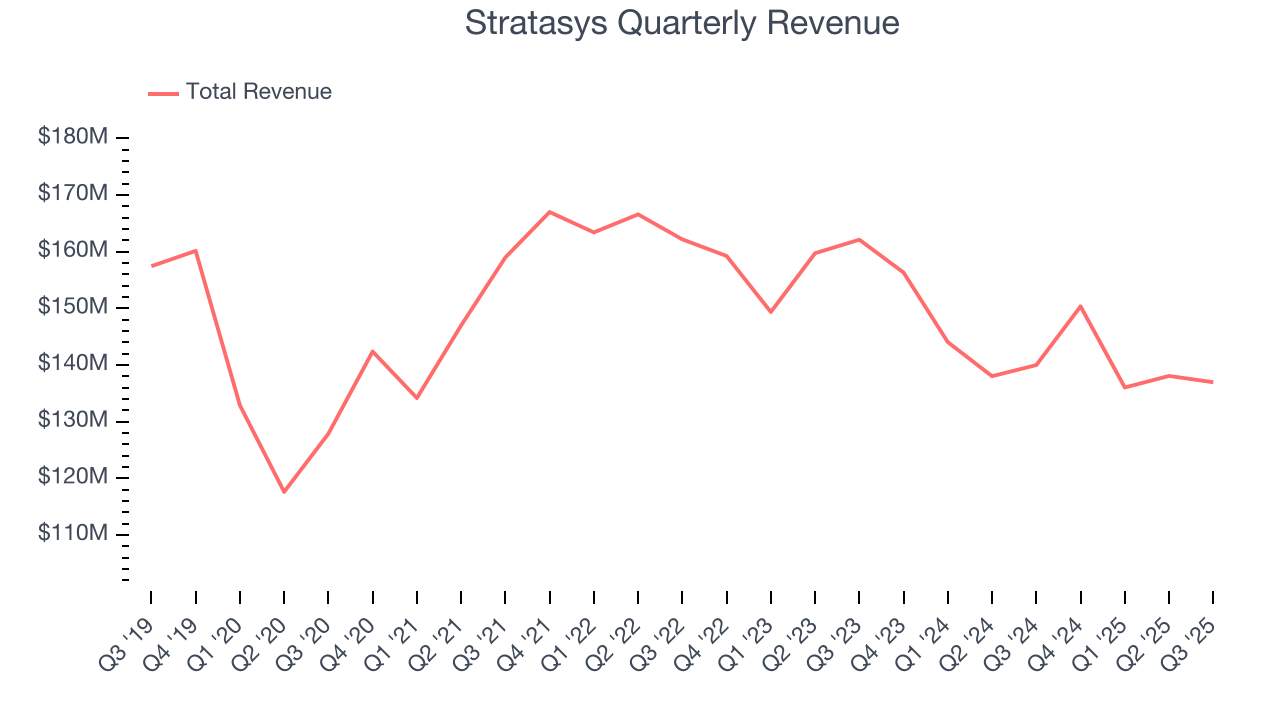
Long-term growth is the most important, but within industrials, a half-decade historical view may miss new industry trends or demand cycles. Stratasys’s recent performance shows its demand remained suppressed as its revenue has declined by 5.6% annually over the last two years. 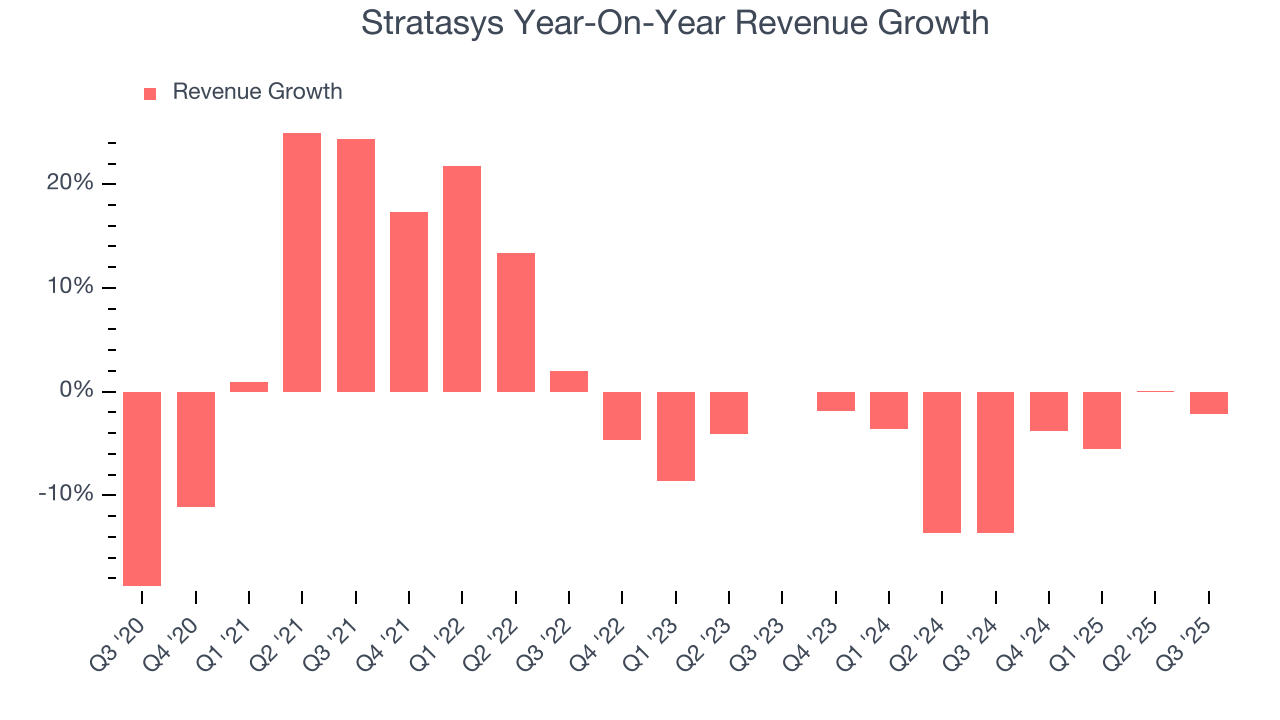
This quarter, Stratasys reported a rather uninspiring 2.2% year-on-year revenue decline to $137 million of revenue, in line with Wall Street’s estimates.
Looking ahead, sell-side analysts expect revenue to remain flat over the next 12 months. While this projection implies its newer products and services will catalyze better top-line performance, it is still below average for the sector.
6. Gross Margin & Pricing Power
All else equal, we prefer higher gross margins because they usually indicate that a company sells more differentiated products and commands stronger pricing power.
Stratasys has best-in-class unit economics for an industrials company, enabling it to invest in areas such as research and development. Its margin also signals it sells differentiated products, not commodities. As you can see below, it averaged an elite 43.6% gross margin over the last five years. That means Stratasys only paid its suppliers $56.39 for every $100 in revenue. 
Stratasys produced a 41% gross profit margin in Q3, marking a 4.8 percentage point decrease from 45.8% in the same quarter last year. Zooming out, the company’s full-year margin has remained steady over the past 12 months, suggesting its input costs (such as raw materials and manufacturing expenses) have been stable and it isn’t under pressure to lower prices.
7. Operating Margin
Operating margin is a key measure of profitability. Think of it as net income - the bottom line - excluding the impact of taxes and interest on debt, which are less connected to business fundamentals.
Stratasys’s operating margin has risen over the last 12 months, but it still averaged negative 12.1% over the last five years. This is due to its large expense base and inefficient cost structure.
Analyzing the trend in its profitability, Stratasys’s operating margin might fluctuated slightly but has generally stayed the same over the last five years, meaning it will take a fundamental shift in the business model to change.
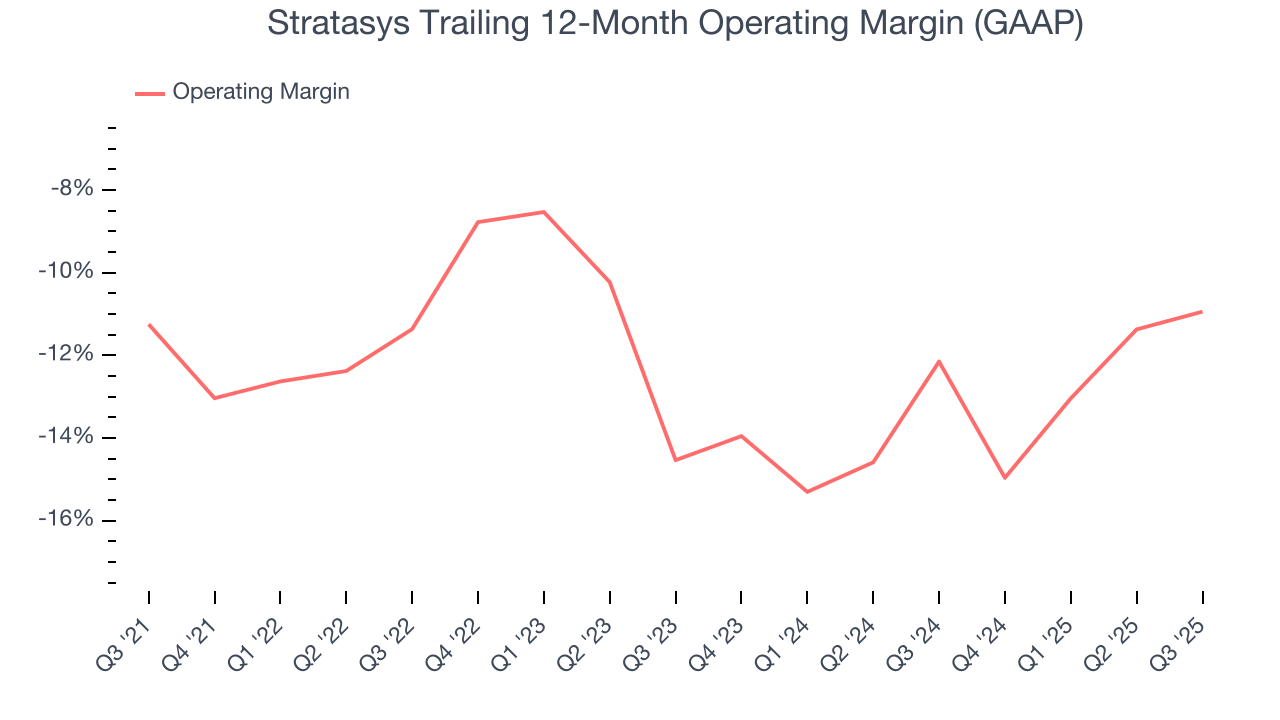
This quarter, Stratasys generated a negative 16.6% operating margin. The company's consistent lack of profits raise a flag.
8. Earnings Per Share
We track the long-term change in earnings per share (EPS) for the same reason as long-term revenue growth. Compared to revenue, however, EPS highlights whether a company’s growth is profitable.
Stratasys’s full-year EPS flipped from negative to positive over the last five years. This is encouraging and shows it’s at a critical moment in its life.

Like with revenue, we analyze EPS over a shorter period to see if we are missing a change in the business.
Stratasys’s EPS grew at a solid 11.1% compounded annual growth rate over the last two years, higher than its 5.6% annualized revenue declines. This tells us management adapted its cost structure in response to a challenging demand environment.
Diving into the nuances of Stratasys’s earnings can give us a better understanding of its performance. Stratasys’s operating margin has expanded over the last two years. This was the most relevant factor (aside from the revenue impact) behind its higher earnings; interest expenses and taxes can also affect EPS but don’t tell us as much about a company’s fundamentals.
In Q3, Stratasys reported adjusted EPS of $0.02, up from $0.01 in the same quarter last year. This print easily cleared analysts’ estimates, and shareholders should be content with the results. Over the next 12 months, Wall Street expects Stratasys’s full-year EPS of $0.21 to grow 5.2%.
9. Cash Is King
Free cash flow isn't a prominently featured metric in company financials and earnings releases, but we think it's telling because it accounts for all operating and capital expenses, making it tough to manipulate. Cash is king.
Stratasys’s demanding reinvestments have drained its resources over the last five years, putting it in a pinch and limiting its ability to return capital to investors. Its free cash flow margin averaged negative 5.1%, meaning it lit $5.11 of cash on fire for every $100 in revenue.
Taking a step back, we can see that Stratasys’s margin dropped by 8.5 percentage points during that time. Almost any movement in the wrong direction is undesirable because it is already burning cash. If the trend continues, it could signal it’s becoming a more capital-intensive business.
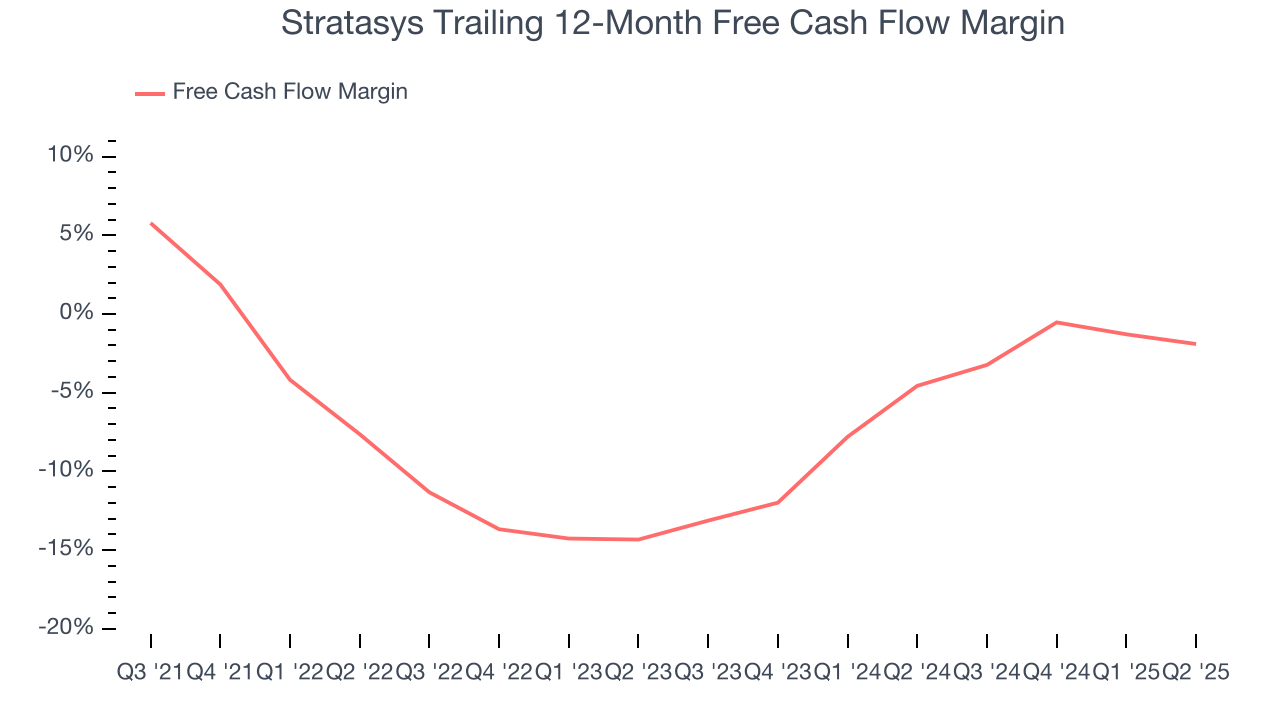
10. Return on Invested Capital (ROIC)
EPS and free cash flow tell us whether a company was profitable while growing its revenue. But was it capital-efficient? Enter ROIC, a metric showing how much operating profit a company generates relative to the money it has raised (debt and equity).
Stratasys’s five-year average ROIC was negative 10.9%, meaning management lost money while trying to expand the business. Its returns were among the worst in the industrials sector.
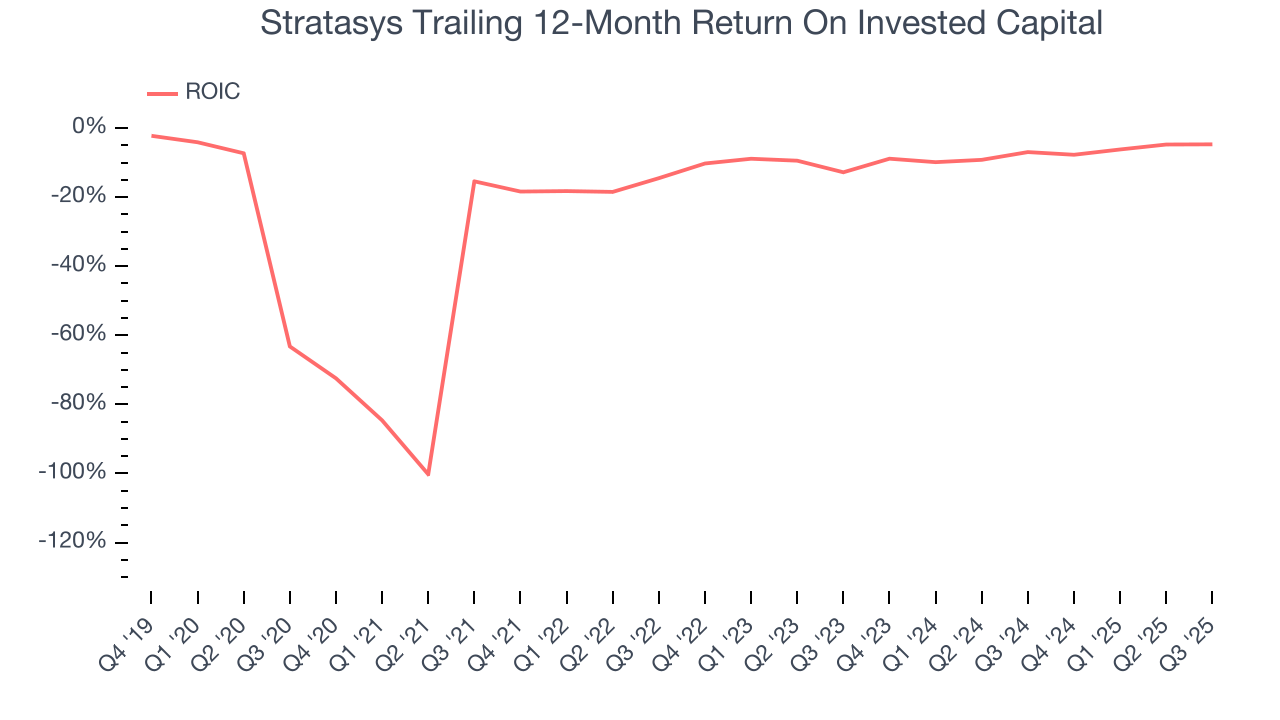
We like to invest in businesses with high returns, but the trend in a company’s ROIC is what often surprises the market and moves the stock price. Over the last few years, Stratasys’s ROIC has increased. This is a good sign, but we recognize its lack of profitable growth during the COVID era was the primary reason for the change.
11. Balance Sheet Assessment
Businesses that maintain a cash surplus face reduced bankruptcy risk.
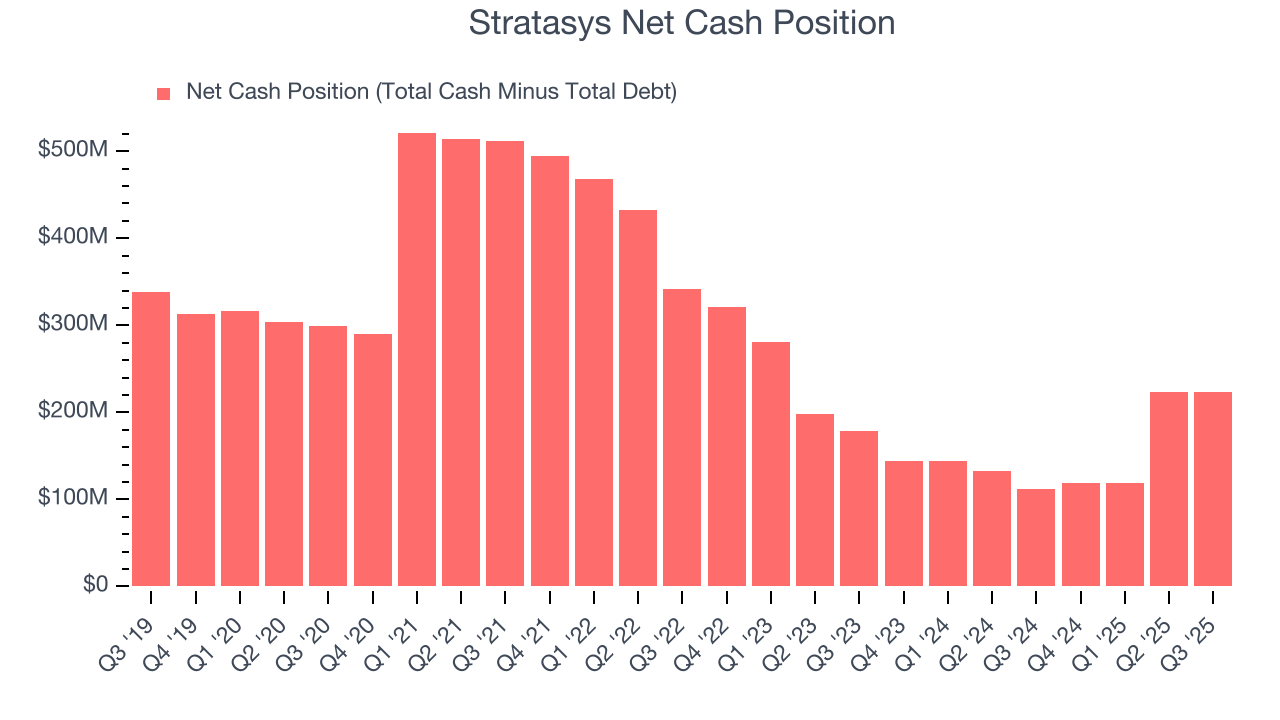
Stratasys is a well-capitalized company with $255 million of cash and $31.09 million of debt on its balance sheet. This $223.9 million net cash position is 28.2% of its market cap and gives it the freedom to borrow money, return capital to shareholders, or invest in growth initiatives. Leverage is not an issue here.
12. Key Takeaways from Stratasys’s Q3 Results
It was good to see Stratasys beat analysts’ EPS expectations this quarter. We were also glad its full-year EBITDA guidance exceeded Wall Street’s estimates. On the other hand, its EBITDA missed. Overall, this print had some key positives. The stock traded up 3.8% to $9.89 immediately following the results.
13. Is Now The Time To Buy Stratasys?
Updated: November 25, 2025 at 10:56 PM EST
Before investing in or passing on Stratasys, we urge you to understand the company’s business quality (or lack thereof), valuation, and the latest quarterly results - in that order.
Stratasys falls short of our quality standards. To begin with, its revenue growth was weak over the last five years, and analysts expect its demand to deteriorate over the next 12 months. And while its astounding EPS growth over the last five years shows its profits are trickling down to shareholders, the downside is its relatively low ROIC suggests management has struggled to find compelling investment opportunities. On top of that, its projected EPS for the next year is lacking.
Stratasys’s P/E ratio based on the next 12 months is 44x. This multiple tells us a lot of good news is priced in - we think other companies feature superior fundamentals at the moment.
Wall Street analysts have a consensus one-year price target of $13.17 on the company (compared to the current share price of $8.52).
Although the price target is bullish, readers should exercise caution because analysts tend to be overly optimistic. The firms they work for, often big banks, have relationships with companies that extend into fundraising, M&A advisory, and other rewarding business lines. As a result, they typically hesitate to say bad things for fear they will lose out. We at StockStory do not suffer from such conflicts of interest, so we’ll always tell it like it is.









